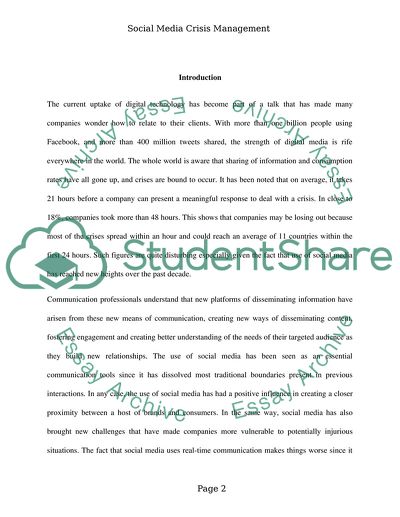Cite this document
(“Issues/crisis management are very important in the digital age Research Paper”, n.d.)
Issues/crisis management are very important in the digital age Research Paper. Retrieved from https://studentshare.org/marketing/1695233-issuescrisis-management-are-very-important-in-the-digital-age-discuss-the-ways-in-which-social-media-immediacy-can-create-challenges-and-opportunities-for-communications-professionals-drawing-on-recent-examples-explain-what-best-practice-looks-like
Issues/crisis management are very important in the digital age Research Paper. Retrieved from https://studentshare.org/marketing/1695233-issuescrisis-management-are-very-important-in-the-digital-age-discuss-the-ways-in-which-social-media-immediacy-can-create-challenges-and-opportunities-for-communications-professionals-drawing-on-recent-examples-explain-what-best-practice-looks-like
(Issues/Crisis Management Are Very Important in the Digital Age Research Paper)
Issues/Crisis Management Are Very Important in the Digital Age Research Paper. https://studentshare.org/marketing/1695233-issuescrisis-management-are-very-important-in-the-digital-age-discuss-the-ways-in-which-social-media-immediacy-can-create-challenges-and-opportunities-for-communications-professionals-drawing-on-recent-examples-explain-what-best-practice-looks-like.
Issues/Crisis Management Are Very Important in the Digital Age Research Paper. https://studentshare.org/marketing/1695233-issuescrisis-management-are-very-important-in-the-digital-age-discuss-the-ways-in-which-social-media-immediacy-can-create-challenges-and-opportunities-for-communications-professionals-drawing-on-recent-examples-explain-what-best-practice-looks-like.
“Issues/Crisis Management Are Very Important in the Digital Age Research Paper”, n.d. https://studentshare.org/marketing/1695233-issuescrisis-management-are-very-important-in-the-digital-age-discuss-the-ways-in-which-social-media-immediacy-can-create-challenges-and-opportunities-for-communications-professionals-drawing-on-recent-examples-explain-what-best-practice-looks-like.


